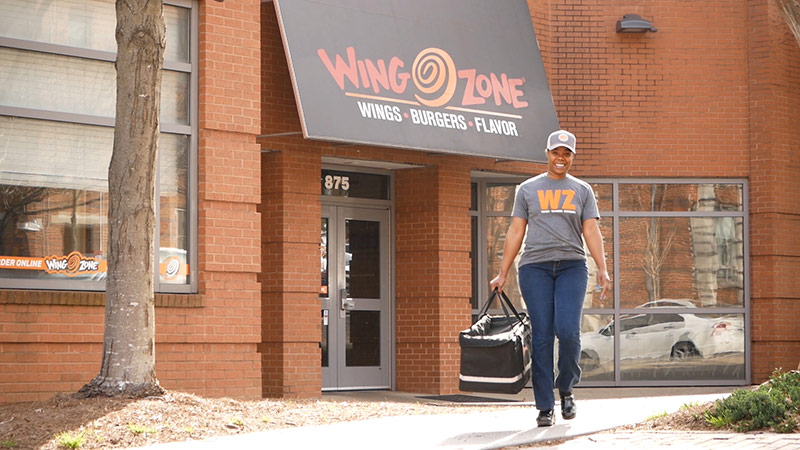Restaurants that self-deliver with their own drivers have seen their ups and downs, as labor costs and availability have fluctuated along with the universal rise of direct-to-consumer convenience. For Atlanta-based Wing Zone, which has always had its own fleet, sales have actually risen during the pandemic as a wave of new applicants apply to work in its restaurants or out on the road.
Even while missing out on the typical March Madness basketball rush for wings and as most college markets have gone quiet, Wing Zone sales have surged in recent weeks, outpacing the same period last year.

Wing Zone CEO Matt Friedman
“For us, direct delivery is a more profitable customer for us,” said co-founder and CEO Matt Friedman. “We want to control the profit, and let’s not pull any punches, these third-party delivery services are charging 30 percent off the top and it’s a huge hit for restaurants.”
While the economics of third-party delivery are well known amid restaurant owners at this point, Friedman said that the pros and cons of an in-house delivery program has shifted over time. At the present moment, however, with people quarantined in their homes, he said that third-party marketplaces now have more competing restaurants than ever.
“It’s interesting how things come full circle,” Friedman added, noting that the brand has had its ups and downs with maintaining driver fleets. “It’s easy to get distracted, just take left turns or right turns and try to adapt, but sometimes you have to stick to your core values and what your core business model is.”
With more than 60 locations in the United States, and 31 international locations, Wing Zone is almost entirely franchised aside from two company-owned stores in its home metro area. While most stores have dining rooms, in-restaurant dining typically makes up less than 10 percent of the system’s overall sales.
Careful to avoid gloating about the brand’s sales rise, Friedman said spinning up a curbside delivery program and getting out there with social media messages for customers and direct communication with franchisees have enabled the current industry-bucking sales gains.
Weeks before the COVID-19 situation became a full-on crisis in the U.S., Wing Zone brought in a member of the Centers for Disease Control to speak to its owners, noting that the Center for Disease Control is also headquartered in Atlanta. The goal of the presentation was going over the basics of sanitation and customer safety, including best practices for contactless deliveries. The brand also rolled out new uniforms and hot bags, as a general refreshing of the appearance and equipment for its delivery drivers.
“In this time, just pulling everyone together and letting people talk is really important, and it’s the beautiful thing of being in a smaller franchise group,” Friedman said.
Having never offered curbside delivery in the past, Wing Zone had to roll out a host of new procedures and standards to franchisees, including limiting customer entry into the restaurants wherever possible. Franchisees are free to set up third-party delivery programs if they choose, but that isn’t commonplace across the chain.
From the stores that do work with third-party providers, Friedman said sales haven’t decreased, but he underscored the impact of so many new restaurants signing up with national delivery brands, which in his eyes lessens the benefit of third-party delivery services in the current moment.
He speculated that Uber and Lyft drivers looking for new options with decreases in personal travel has partially fueled the surge in driver applications, going so far to call the current labor pool “plentiful,” which is a massive shakeup from the recent norm in the restaurant industry and beyond.
Existing Wing Zone drivers are finding that consumers have been incredibly generous in recent weeks. Some drivers have said they aren’t comfortable delivering due to a fear of personal exposure, and he said they have been accommodating such concerns.
Looking ahead to some future normalcy, Friedman said he expects a lot of restaurants to fail, which is a sad, but likely necessary, reset for the industry that’s had an overabundance of restaurants per capita. When things do reopen, he expects a surge in office and catering orders, as well as from people who have had recent, positive delivery experiences with the brand.
After closing locations in Asian markets, all locations have now reopened in Singapore, Malaysia and the Philippines as the disease appears to have passed its peak in the continent. In Central America, with locations in Panama and Guatemala, all five mall-based locations are closed, with the other traditional locations seeing restricted hours. Friedman said those markets have been more chaotic, with changing or sometimes conflicting information provided from government officials.
“Every challenge has an opportunity, it doesn’t mean we’re capitalistic or greedy,” he said. “There’s gotta be something good that comes of this for your particular brand or business, so we’re just looking at it from that perspective. I have a corporate team and a franchisee network with that mentality, and it’s contagious.”


